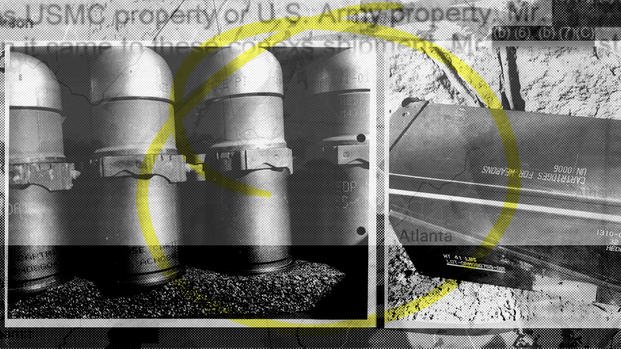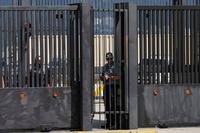The green, metal box was stuffed inside a bright pink pillowcase and stashed in the bushes behind Christopher Zachery’s house. He hauled it out for a better look.
Stenciled on the box: “Cartridges for weapons.” Inside were 30 armor-piercing grenades.
“I was scared,” said Zachery, who runs a construction company. And confused. How did these high-powered explosives end up in his southwest Atlanta backyard? Where did they come from?
Investigators determined the waylaid grenades were last seen eight month prior on an ammunition train that rolled out from Florida. Someone had stolen them somewhere on the rails to Pennsylvania, another example in an Associated Press investigation that shows how the military’s vast supply chain is susceptible to theft.
Marines call the squat, 40mm rounds that appeared in Zachery’s yard on that sunny morning in February 2018 “40 mike-mikes.” They’re linked together to feed into an MK 19 launcher, a weapon that is like a machinegun for grenades, able every second to shoot one nearly a mile.
Awaiting the bomb unit, Atlanta police evacuated five houses in both directions, as well as neighbors across the street. The rounds can penetrate three inches of steel and have a kill radius of nearly 50 feet.
The canister began its journey at Blount Island, a U.S. Marine Corps depot in Jacksonville, Florida. Six flatbed rail cars hauled 18 large storage containers known as conex boxes, each with an orange sign warning “Explosives” on its side. On car DODX48916, inside container USMC007574-6, canisters of the 40 mm rounds were stacked like soldiers in bunks.
The train’s circuitous route passed through Atlanta twice before it arrived 17 days later at Letterkenny Army Depot in central Pennsylvania. There, a worker unpacking the container discovered the theft.
Where, when, who, how -- investigators were at a loss.
A series of security failures covered any tracks the thief left.
Armed guards who accompanied the shipment reported nothing. When the train reached Letterkenny, it was shuttled for the night to Rail Yard 1, an unsecured staging area outside the installation with no surveillance.
Upon arrival, workers didn’t verify whether anti-theft seals on each container were intact. An inspector didn’t check the seals the next day either, later saying it was because he couldn’t see them.
Yet another day passed before workers noticed the broken seals. The first laborer who saw the severed wooden framing used to hold pallets of canisters together thought it broke in transit. Then he noticed a metal strap that holds each canister snugly to the wood also was cut, and one box was gone.
Military investigators would conclude that no one checked the seals in the weeks after the train departed Blount Island.
Workers unpacked the entire container to see whether anything else was stolen, disposing of debris. For investigators, that meant the crime scene near loading dock X-11-G was contaminated beyond repair.
The Pentagon’s inspector general wrote that the disappearing grenades “further emphasized the lack of proper security for rail shipments” of military arms, explosives and ammunition.
The military doesn’t have a centralized tracking system for rail shipments like this one, instead relying on contractors to deliver the arms and explosives safely. This shipment was the responsibility of rail freight giant CSX Corp., which provided everything from locomotive and tracks to guards and engineers to the dozen or so rail yards where the train stopped along the way.
CSX said in a statement that required security protocols were followed during the shipment and that “no seal exceptions were identified while the container was in our possession.”
The last hope of finding clues came when the grenades showed up in Atlanta. But instead of treating the canister as evidence, explosives specialists from Dobbins Air Reserve Base took it and blew it up.
There was just one thing. The canisters are packed with 32 rounds. This one only had 30.
Two remain missing.
Hall reported from Nashville, Tennessee; Pritchard reported from Los Angeles.











